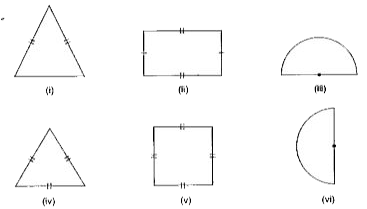वह बड़ी-से-बड़ी संख्या, जिससे 171 तथा 251 में भाग देने पर क्रमशः 3 तथा 6 शेष बचें, होगी
(i) 3
(ii) 5
(iii) 7
(iv) 15
The correct Answer is:(iii)
Step by step video, text & image solution for वह बड़ी-से-बड़ी संख्या, जिससे 171 तथा 251 में भाग देने पर क्रमशः 3 तथा 6 शेष बचें, होगी (i) 3 (ii) 5 (iii) 7 (iv) 15 by Maths experts to help you in doubts & scoring excellent marks in Class 6 exams.
Topper's Solved these Questions
- BOOK - DAS GUPTACHAPTER - संख्याओं के साथ खेलना EXERCISE - प्रश्नमाला 3 (H)18videos
संख्याओं के साथ खेलना
- BOOK - DAS GUPTACHAPTER - संख्याओं के साथ खेलना EXERCISE - प्रश्नमाला 3 (I)12videos
संख्याओं के साथ खेलना
- BOOK - DAS GUPTACHAPTER - संख्याओं के साथ खेलना EXERCISE - प्रश्नमाला 3 (F)14videos
संख्याओं के साथ खेलना
- BOOK - DAS GUPTACHAPTER - संख्याओं की जानकारी EXERCISE - प्रश्न (रिक्त स्थान)2videos
संख्याओं की जानकारी
- BOOK - DAS GUPTACHAPTER - सममितिEXERCISE - प्रश्नमाला 161videos
सममिति
Similar Questions
4 और 6 का लघुतम समापवर्त्य निम्नांकित में कौन-सा होगा ?
(i) 4
(ii) 6
(iii) 4×6
(iv)1203:02View Solutionविभाजन विधि द्वारा लघुतम समापवर्त्य ज्ञात कीजिए।
16,8 और 4802:04View Solution632 और 320 का महत्तम समापवर्तक निम्नांकित में कौन-सा होगा ?
(i) 4
(ii) 2
(iii) 8
(iv) इनमे कोई नहीं05:25View Solution1 मिलियन = ……………. दस हजार।
02:10View Solutionनिम्नांकित चित्रों में सभी संभावित सममिति रेखा खींचें।
 View Solution
View SolutionWhich of the following symbols are not acceptable ? (i) ._(35)^(79)Br (ii) .^(79)Br (iii) ._(79)^(35)Br (iv) ._(35)Br
02:40View SolutionThe value of |[a,a+d,a+2d] , [a+d,a+2d,a+3d] , [a+2d,a+3d,a+4d]|+|[b
View SolutionThe SN1 reactivity of the following halides will be in the order:
(i) (CH3)3C−Br
(ii) (C6H5)CHBr
(iii) (C6H5)2C(CH3)Br
(iv) (CH3)2CHBr
(v) C2H5BrView SolutionIn CH_(3)CH_(2)Br,% of Br is
01:21View SolutionPredict all order of reactivity of the following compounds in dehydrohalogenation. a,. I. CH_(3)CH_(2)CH_(2)CH_(2)Cl II. (CH_(3))_(2)CHCH_(2)Cl III. (CH_(3))_(2)CH - CH_(2)Br IV. CH_(3)CH(Br)CH_(2)CH_(3) V. (CH_(3))_(3) C - Br b. I. CH_(3)CH(Br)CH_(3) II. CH_(3)CH_(2)CH_(2)Br III. (CH_(3))_(2) CH - CH_(2) Br IV. (CH_(3))_(3)C - CH_(2) Br
01:15View Solution[Co(NH3)5Br]SO4 तथा [Co(NH3)5SO4]Br किसके उदाहरण है ?
04:55View SolutionArrange the following in increasing order of the property indicated.
(i) F, Cl, Br and I (negative electron gain enthalpy)
(ii) Mg2+,O2−,Na+,F−andN3− (ionic size)
(iii) Mg, Al, Si and Na (ionization enthalpy)
(iv) Br+BrandBr− (size)02:00View SolutionArrange the following compounds in increasing order of acidity.
(i) CH3CH(Br)CH2COOH
(ii) CH3CH2CH(Br)COOH
(iii) CH3CH2C(Br)2COOH
(iv) CH2BrCH2CH2COOH01:51View Solutionఏ అవయవాలు కవాటాలు కల్గి ఉంటాయి ?br i) గుండెbr ii) ధమనిbr iii) సిరలుbr iV) శోషరస నాళాలు
01:38View Solutionవేర్ల ద్వారా శాఖీయోత్పత్తి జరిపే మొక్కbr i) డాలియాbr ii) ముల్లంగిbr iii) క్యారెట్br iv) క్యాబేజిbr
05:43View SolutionCH_(3)Br+Nu^(-)rarrCH_(3)Nu+Br^(-) The decreasing order of the rate of the above reaction with nucleophiles (Nu^(-)) I to IV is : [Nu^(-)=(I)PhO^(-),(II)AcO^(-),(III)HO^(-),(IV)CH_(3)O^(-)]
04:06View Solution

